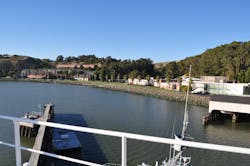Cal State Campus Receives Federal Funds for a Solar Microgrid
California State University Maritime Academy (Cal Maritime), the only degree-granting maritime academy on the West Coast, has been awarded $1 million in federal money for a campus microgrid project.
The funds, which were part of the December 2022 federal spending bill, were supported by the offices of Sen. Dianne Feinstein, D-Calif., and Sen. Alex Padilla, D-Calif. They will be used to cover the acquisition and installation costs of a photovoltaic microgrid that will provide basic power to the campus and reduce its energy costs.
The microgrid will also shrink Cal Maritime’s carbon footprint and its dependency on the electric grid, provide emergency power and serve as an educational tool for its students.
Campus microgrids also benefit their neighbors
“Installing a solar energy microgrid is both sustainable and a strategic resource for campus resilience,” said Padilla. He noted that the microgrid will help Cal Maritime during emergencies as well as help the campus reach its energy and sustainability goals.
“This project will be a learning and living opportunity for Cal Maritime faculty, students, staff and neighboring communities,” said Thomas Cropper, Cal Maritime’s president. He added that it will provide environmental, social, educational and economic benefits to the school and its neighbors for many years.
Feinstein agreed, saying that the “independent, renewable energy system will benefit not only campus sustainability efforts but also the local community and environment.”
Cal Maritime tackles sustainability goals from all angles
The 92-acre Cal Maritime campus is located in Vallejo, California, and enrolls around 1,000 students per year, both on campus and through extended learning programs.
The solar microgrid is part of the campus’ efforts to achieve carbon neutrality by 2029. According to a recent tweet from Feinstein, it will provide a third of the campus’ total energy needs.
Energy efficiency initiatives, such as retrofitting streetlights and parking lot lights with LED fixtures, have also been introduced across campus to help support this goal.
All these efforts support the larger California State University (CSU) system’s goal of implementing sustainability initiatives across each of its 23 campuses. CSU has set a systemwide goal of acquiring 60% of its electricity from renewable sources by 2030.
Cal State campuses involved in microgrid development
Other campuses in the Cal State system have also been involved in developing microgrids. The Schatz Energy Research Center at Cal Poly Humboldt is one of the partners in the Redwood Coast Airport Microgrid.
In 2018, Cal Maritime announced that it was working on designs for a wind turbine microgrid that could be used by the offshore aquaculture industry.
Track news about campus microgrids. Subscribe to the free Microgrid Knowledge Newsletter.
About the Author
Kathy Hitchens
Special Projects Editor
I work as a writer and special projects editor for Microgrid Knowledge. I have over 30 years of writing experience, working with a variety of companies in the renewable energy, electric vehicle and utility sector, as well as those in the entertainment, education, and financial industries. I have a BFA in Media Arts from the University of Arizona and a MBA from the University of Denver.

